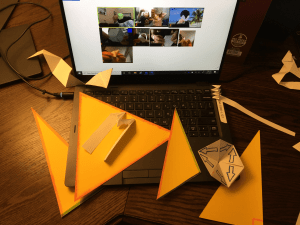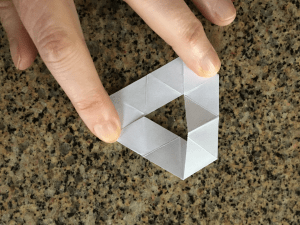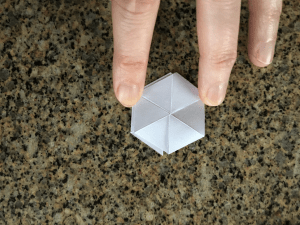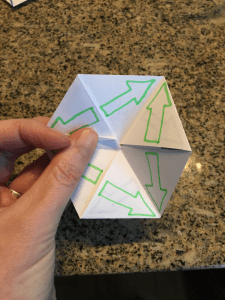This went well today.
Here is a printout that helps to frame thinking around the work we engaged in today: Primary shape exploration-rdblqc
Here is a printout for creating shape shifters: Hexagon-19fuvsq Hexagon-19fuvtg
But! Before I launch into a lesson play-by-play, I feel I need to relate my angst over this….
 Shape shifters (this funky, home-made tool made from 12 right angle triangles) has such potential to facilitate meaningful exploration of the way shapes move and transform, and to genuinely connect to story and culture across grade levels (K-7). It’s one of the best ideas that I’ve ever had and I want it to work!! So: I have been really really working on distilling all my many observations and connections down to some thing clear and, yes, elegant. It’s taken YEARS of tinkering. Plus, I’ve been trying to create those key questions (provocations) to set an inviting table for the kids. And I have been thinking hard about how things change and become more complex as kids get older. Phew! Thanks for that. Now onto what happened today…
Shape shifters (this funky, home-made tool made from 12 right angle triangles) has such potential to facilitate meaningful exploration of the way shapes move and transform, and to genuinely connect to story and culture across grade levels (K-7). It’s one of the best ideas that I’ve ever had and I want it to work!! So: I have been really really working on distilling all my many observations and connections down to some thing clear and, yes, elegant. It’s taken YEARS of tinkering. Plus, I’ve been trying to create those key questions (provocations) to set an inviting table for the kids. And I have been thinking hard about how things change and become more complex as kids get older. Phew! Thanks for that. Now onto what happened today…
I was invited into a grade 1/2 class today. The previous week, students had already created their shape shifters and I had used my new die-cut to chop it into congruent right-angle triangles. Today was the test drive. I decided to focus on three key ideas:
- Shapes can transform into other shapes
- When you use your imagination, shapes can transform into analogous objects (i.e.: this triangle is like a hat!)
- Characters in Northwest Coast stories sometimes transform, too
To begin, I read Raven by Gerald McDermott. What does Raven have to do with shapes? The students noticed lots of colourful shapes on Raven’s wings. I explained that shapes transform and what it means to transform. I asked them to listen to the story and notice when a transformation was occurring.
Next, we pulled out 2 shifters from the set. It is important to start with a small number of shifters, especially for primary! If you start with more than 2, it can be too tricky for kids. We explored the following question:
How can these two shapes transform?
In the initial exploration, I wandered around and interacted with students, asking “How did you do that? What does that look like to you?”
Next, I stopped them and popped up a picture of two shifters forming a triangle, asking:
How might you make this shape?
After making it, I pulled everyone down to the carpet to discuss this first shape using the following question:
What is special about this shape?
And then….
Does this shape have a name?
Next, I challenged them to transform it using their imaginations, thinking about what it reminds them of.
How does it transform in your imagination?
Before introducing the next challenge, I decided to go out on a limb and talk about shape movements (slides, rotations and flips). This is not a part of the primary curriculum, but I felt that it might be helpful for some know what movements they might test to make new shapes. I encouraged everyone to hold up their fingers in a triangle shape, pulling them apart to show a slide, turning to rotate and flipping one hand to show, well, flipping (all with sound effects, of course).
I popped up the next picture and we repeated the whole process from building to discussing. There were gasps when they realized we had just made a three-sided shape transform into a 4-sided shape. And then we ran out of time!
Not a perfect lesson, but I felt like I’d accomplished something nevertheless. Here are my wishes and take-aways:
- I wish I had framed the Raven story differently. It would have been fun if I had let them know that there was math hiding in this story and asked them to carefully listen for the math. You could do this with older students, too.
- It really was challenging to transform just 2 right angle triangles! It makes me wonder if the K-2 level should just create an equilateral triangle tool split into 2 right angle triangles. Once they get good at working with 2, they can partner up and see what else they can make. Not a bad idea, really. This allows the tool to grow and remain fresh as students get older. A definite plus and a potential solution to a problem that has worried me.
- Teaching younger students about shape movements seems to be helpful. I love that they seem really useful and give kids options to deliberately test. So much better than the superficial nod they get in intermediate.
- The two layers of transformations (physical and imaginative) seem to be really compelling for young students. This will allow them to connect to story later, using their shifters to represent characters, objects and ideas.
We’ll continue to play with this after the break!
Want a bit more background on this project? Click here to read the 2017 Vector Magazine article I wrote on the subject.

 Prefer a printout? Here you go:
Prefer a printout? Here you go: 










 An interesting way to start off a unit! Watch the video and see if they can figure out the theme!
An interesting way to start off a unit! Watch the video and see if they can figure out the theme! Shape shifters (this funky, home-made tool made from 12 right angle triangles) has such potential to facilitate meaningful exploration of the way shapes move and transform, and to genuinely connect to story and culture across grade levels (K-7). It’s one of the best ideas that I’ve ever had and I want it to work!! So: I have been really really working on distilling all my many observations and connections down to some thing clear and, yes, elegant. It’s taken YEARS of tinkering. Plus, I’ve been trying to create those key questions (provocations) to set an inviting table for the kids. And I have been thinking hard about how things change and become more complex as kids get older. Phew! Thanks for that. Now onto what happened today…
Shape shifters (this funky, home-made tool made from 12 right angle triangles) has such potential to facilitate meaningful exploration of the way shapes move and transform, and to genuinely connect to story and culture across grade levels (K-7). It’s one of the best ideas that I’ve ever had and I want it to work!! So: I have been really really working on distilling all my many observations and connections down to some thing clear and, yes, elegant. It’s taken YEARS of tinkering. Plus, I’ve been trying to create those key questions (provocations) to set an inviting table for the kids. And I have been thinking hard about how things change and become more complex as kids get older. Phew! Thanks for that. Now onto what happened today…